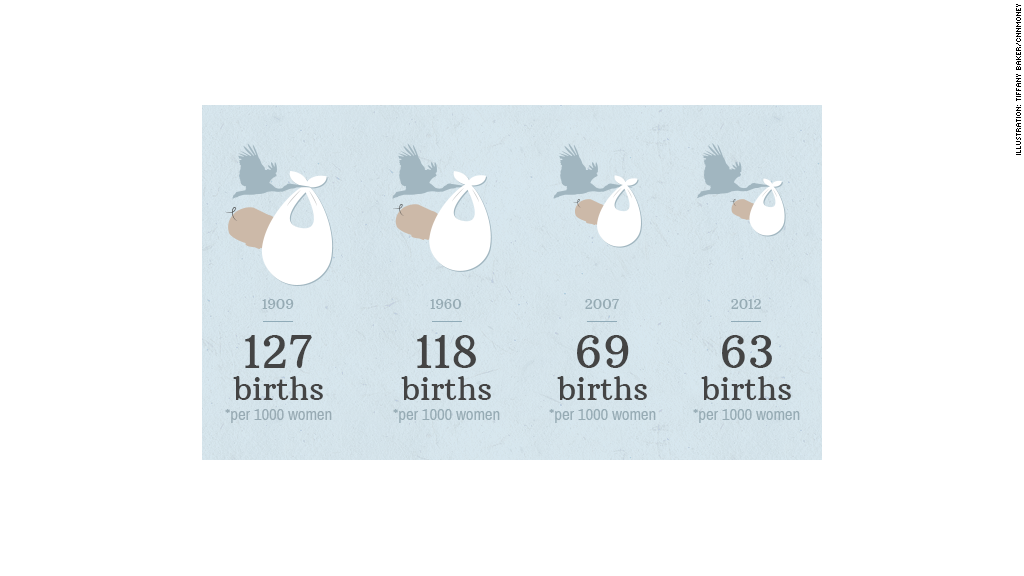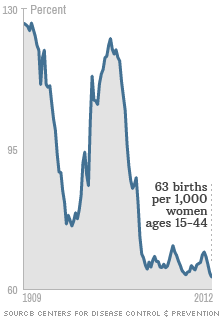
The Great Recession and the slow recovery have been quite the romantic buzzkill.
The U.S. fertility rate fell to another record low in 2012, with 63.0 births per 1,000 women ages 15 to 44 years old, according to the Centers for Disease Control and Prevention. That's down slightly from the previous low of 63.2 in 2011.
 |
It marked the fifth year in a row the U.S. birth rate has declined, and the lowest rate on record since the government started tracking the fertility rate in 1909. In 2007, the rate was 69.3.
Falling birth rates can be considered a challenge to future economic growth and the labor pool.
"If there are fewer younger people in the United States, there may be a shortage of young workers to enter the labor force in 18 to 20 years," said University of New Hampshire demographer Kenneth Johnson. "A downturn in the birth rate affects the whole economy."
It takes 2.1 children per woman for a given generation to replace itself, and U.S. births have been below replacement level since 2007.
As of last year, a separate CDC analysis shows an American woman will give birth to an average of 1.88 children over her lifetime, also a record low.
Related: Did you postpone plans to have a baby for economic reasons?
The birth rate has largely been declining since the post-World War II baby boom, but that fall accelerated during the Great Recession, as high unemployment derailed many young people's plans to move out and start families.
About 22% of 18-to-34-year-olds surveyed by the Pew Research Center in December 2011 said they had postponed having a baby because of economic conditions.
Even in 2012 -- three years after the recession officially ended -- 36% of Millennials ages 18 to 31 still lived at home with their parents, according to Pew analysis of U.S. Census data.

But here's the good news: The declines have slowed and demographers believe the birth rate may level off going forward.
"The decline in fertility rates, which had been dramatic, is stabilizing," Johnson said.
Demographic Intelligence, a firm that forecasts birth rates for clients like Disney (DIS), Fisher-Price, Gerber and Procter & Gamble (PG), predicts the birth rate will rise in 2013, to 1.9 children per woman.
"We think that this fertility decline is now over. As the economy rebounds and women have the children they postponed immediately after the Great Recession, we are seeing an uptick in U.S fertility," Sam Sturgeon, president of Demographic Intelligence, said in a statement.
To be sure, birth rates are a lagging economic indicator, reflecting decisions made at least nine months earlier.
"In the 2012 data, you're seeing what women were thinking about in 2011," Johnson said. "If the economy were to be picking up now, you're not seeing that in the birth patterns yet. It will be another year until you'll see the effect of that."
Related: Why 26% of U.S. women still choose not to work
While overall fertility rates have fallen, trends vary by age, race and ethnicity.
For example, the fertility rate decreased among teenagers and women in their 20s, but rose slightly among those over age 30.
It held steady for white women, fell among blacks and Hispanics, and rose among Asians and Pacific Islanders last year.
Overall, about 3.95 million babies were born in 2012.


